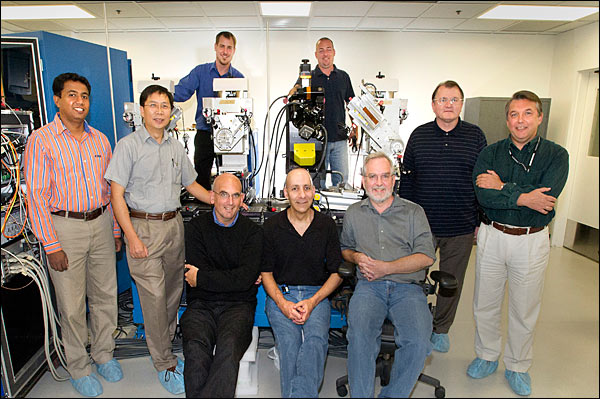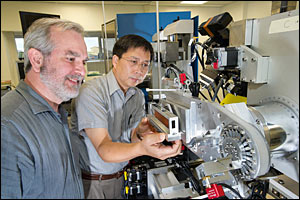NSLS-II IXS Beamline Achieves Key R&D Goal
September 28, 2011
The group developing the NSLS-II inelastic x-ray scattering (IXS) beamline, one of the facility's six “project” beamlines, recently reached an important development milestone. In tests of the optics systems that make up the heart of the beamline, the researchers achieved an energy resolution as low as 0.9 meV, an accomplishment that suggests they are well on their way to their final goal of 0.1 meV.

The IXS team: (sitting, from left) Alessandro Cunsolo, David Levy, and Scott Coburn; (standing, from left) Nalaka Kodituwakku, Yong Cai, Jeff Keister, Leo Reffi, Yuriy Stetsko, and Alexey Suvorov.
Resolution is a measure of the x-ray beam's overall quality and refers to how far the energy of the beam differs from its target energy, which for the IXS beamline is approximately 9.13 keV (9.13 kilo-electron-volts, or 9,130 eV).
“We're very excited that we've taken the first step toward our ultimate goal of 0.1 meV,” said Yong Cai, the IXS group leader. “But it's been quite difficult.”
The basic optical structure of the beamline consists of a lens to focus the x-ray beam and a series of crystal-based monochromators, which are devices designed to extract x-rays of a particular energy from the beam as it is siphoned off the main storage ring. In practice, even the best monochromators deliver x-rays with a range of energies. Making that range as small as possible – in other words, making the resolution as small as possible – is key to ensuring the beamline will perform as promised.

Scott Coburn (left) and Yong Cai inspect the alignment of a crystal holder, one of three holders that house the trio of crystals that make up the IXS beamline's monochromator.
At the energies produced by NSLS-II, it is much harder to achieve a small resolution, due to the ways x-rays diffract in a crystal, and Cai and his group have been working toward this goal for three years. Among their efforts were determining how to build an optical setup that is mobile, so that it can be shipped to other third-generation synchrotrons for testing.
The first test, in February 2011, took place at the SPring-8 synchrotron in Japan. When that didn't go as well as anticipated, the group shipped the system back to NSLS to work on it further. They learned how to better align the optical components and installed a higher quality set of crystals, ordered from a Japanese company.
In July, they brought the system back to SPring-8 for a second test, where they measured a resolution of 0.9 meV. They also achieved an impressive “spectral efficiency,” a property that ultimately determines the intensity of the beam. Their target was 10 percent, but they measured rates up to 20 percent.
Since July's test didn't incorporate all of the beamline's optical components, further tests are scheduled. The next round, in October and November, will take place at the PETRA III synchrotron in Germany, followed by a trip back to SPring-8 in February.
The members of the IXS R&D group also include Jeff Keister, Scott Coburn, Yuriy Stetsko, Nalaka Kodituwakku, Alexey Suvorov, Leo Reffi, David Levy and Alessandro Cunsolo.
- Laura Mgrdichian, Photon Sciences Science Writer
2011-2657 | INT/EXT | Newsroom









